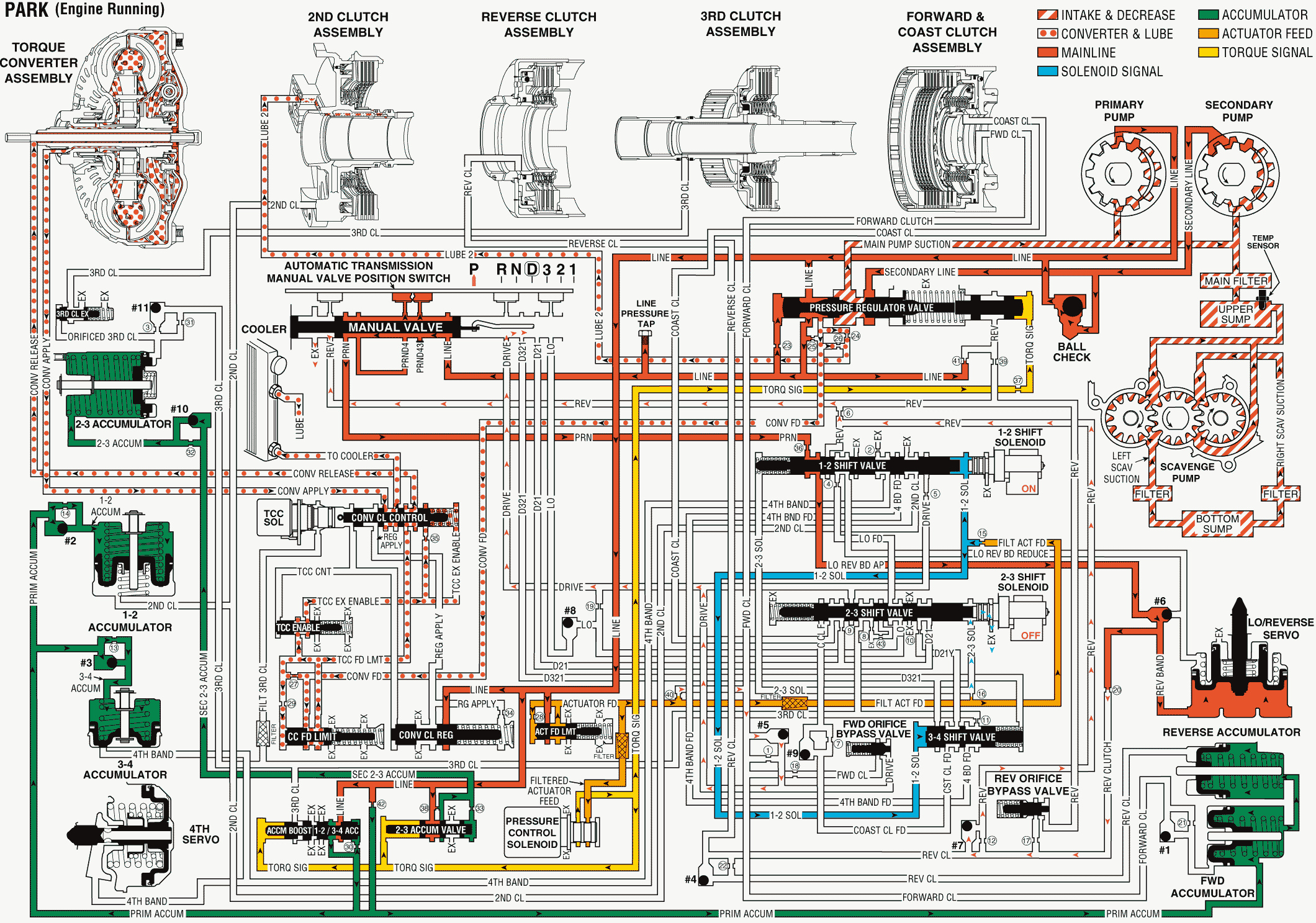When the gear selector lever is in the Park (P) position and the engine is running, fluid is drawn into the scavenger pump from the bottom pan and routed into the side cover. From the side cover, fluid is drawn through the main filter into the primary and secondary oil pump assemblies. Line pressures from the primary and secondary oil pump assemblies are then directed to the following control devices:
Pressure Regulation
Pressure Regulator Valve
This valve regulates the pump output in response to several forces: torque signal, fluid pressure, reverse gear, orificed line pressure and spring force. Line pressure from this valve is then routed to the actuator feed limit valve, the 1-2 & 3-4 accumulator valve, the 2-3 accumulator valve, and the converter clutch regulating valve.
Actuator Feed Limit Valve
The line pressure is limited to a maximum force as it passes through the actuator feed limit valve and enters the actuator feed circuit. Actuator feed is then routed to the pressure control solenoid valve, and into the fluid circuits of the 1-2 and the 2-3 shift solenoid valves.
Shift Accumulation
1-2 & 3-4 Accumulator Valve
This valve is biased by the torque signal, the third clutch and the orificed primary accumulator pressures. This valve regulates primary accumulator pressure. Fluid pressure from the primary accumulator is routed to the spring side of the forward accumulator piston, checkball #2 and checkball #3.
#2 Checkball (Primary Accumulator/1-2 Accumulator)
The #2 checkball is located in the accumulator housing. The checkball is seated against the spacer plate in order to route primary accumulator fluid through orifice #14 and to the spring side of the 1-2 accumulator piston.
#3 Checkball (Primary Accumulator/3-4 Accumulator)
The #3 checkball is located in the accumulator housing. The checkball is seated against the spacer plate in order to route primary accumulator fluid through orifice #13 and to the spring side of the 3-4 accumulating piston.
2-3 Accumulator Valve
This valve is biased by the torque signal and by the orificed secondary 2-3 accumulator pressures and the spring force. The 2-3 accumulator valve regulates the 2-3 accumulator circuit pressures. Line pressure at the valve feeds into the secondary 2-3 accumulator circuit and is then routed to checkball #10.
#10 Checkball (2-3 Accumulator)
The #10 checkball is located in the case cover. The checkball is seated against the spacer plate in order to route secondary 2-3 accumulator fluid through orifice #32 and then into the 2-3 accumulator circuit. Fluid from the 2-3 accumulator is then routed to orifice #32 and then to the spring side of the 2-3 accumulating piston.
Hydraulic Controls
Manual Valve
The manual valve is mechanically controlled through the gear selector lever. The valve directs line pressure from the pressure regulator valve to the pressure switches and also into the PRN, the PRND4 and the PRND43 circuits.
Automatic Transmission Manual Valve Position Switch
The automatic transmission manual valve position switch is a device containing five hydraulically activated pressure switches which are monitored by the Powertrain Control Module (PCM). These switches are normally open. The switches close or open electrical circuits when hydraulic fluid acts on the diaphragm inside the switches. This action provides information to the PCM regarding the position of the manual valve. In Park, the PRND4 and the PRND43 switches are closed. This completes their electrical circuits.
Pressure Control (PC) Solenoid Valve Feed Filter
The PC solenoid valve feed filter is located in the valve body. This device filters the actuator feed fluid before the fluid is routed to the PC solenoid valve.
Pressure Control (PC) Solenoid Valve
The Pressure Control (PC) Solenoid Valve is controlled by the PCM. This valve regulates the filtered actuator feed pressure which enters the torque signal circuit. Torque signal fluid is then routed to the pressure regulator valve, the 1-2 & 3-4 accumulator valve, and the 2-3 accumulator valve.
The 1-2 Shift Solenoid (SS) Valve
The 1-2 SS valve is energized (turned ON) by the PCM, blocking the exhaust port through the solenoid. This creates high pressure in the 1-2 shift solenoid valve circuit. Solenoid pressure holds the 1-2 shift valve in the downshifted position. This pressure is also routed to the 3-4 shift valve.
The 2-3 Shift Solenoid (SS) Valve
The 2-3 SS valve is de-energized (turned OFF) by the PCM, which allows fluid in the solenoid valve circuit to exhaust. Filtered actuator feed enters the solenoid valve circuit through orifice #16. This feed exhausts though the solenoid valve.
The 1-2 Shift Valve
High pressure from the 1-2 SS valve holds this valve in the downshifted position. PRN fluid passes between two valve lands and enters the Low & Reverse band apply fluid passage.
The 3-4 Shift Valve
Fluid from the 1-2 SS valve is routed to the end of the 3-4 shift valve against spring force, holding it in an upshifted position.
#6 Checkball (Low/Reverse Band Apply/Reduce)
This checkball is located in the valve body. The checkball seats against the Low & Reverse band reduce passage and routes fluid to the Low & Reverse servo piston.
Torque Converter/Cooler and Lube
Refer to Reverse .
Park - Engine Running

